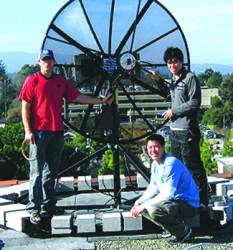Yes, I was the fellow who in 1999 launched a magazine called Galileo’s World.
It’s also true that I did make a rather exuberant toast at a conference dinner in St. Petersburg in 1996 about the prospects for GLONASS.
And even before that, I published an article that said the GPS Wide Area Augmentation System (WAAS) would be available for all phases of flight by 1997. (At least, that prediction was made by an expert in the field, not me.)
Yes, I was the fellow who in 1999 launched a magazine called Galileo’s World.
It’s also true that I did make a rather exuberant toast at a conference dinner in St. Petersburg in 1996 about the prospects for GLONASS.
And even before that, I published an article that said the GPS Wide Area Augmentation System (WAAS) would be available for all phases of flight by 1997. (At least, that prediction was made by an expert in the field, not me.)
So, maybe I have been a little early into the marketplace of ideas from time to time. Certainly, each of those occasions was followed by a distinctly adverse turn of events for the system involved. As singer Bob Seger would say, sometimes I wish I didn’t know now what I didn’t know then.
Considering that spotty record, it’s reasonable to expect that some readers might hesitate getting on the bandwagon when I say something like “the Golden Age of GNSS” — a phrase that I didn’t come up with but one for which I’ll claim credit if things turn out okay.
Seriously, though, I believe one can justifiably argue that the coming year will mark the beginning of the Golden Age of GNSS.
Why?
At first glance, such a notion might seem not just optimistic, but noticeably ill-timed. After all, in 2009 all four of the aspiring GNSS systems hit some sizable potholes in the road:
- GPS launched a satellite (SVN49) that has still not been set healthy because of an onboard multipath problem. And the Air Force placed the last available GPS satellite in orbit while the first launch of the next-generation satellite got pushed back again.
- Russia had to postpone its September launch for several months because of payload problems in an operational satellite. And its traditional December 25 launch may be in doubt.
- European officials finally had to admit that they were a little too short of time and money to be able to get a fully operational system into place by 2013.
- And China appears to have launched fewer satellites than its ambitious schedule of a year or so ago would have suggested.
Meanwhile, casting a pall over the GNSS industry is the wake of a severe recession that still haunts much of the global economy.
But it is exactly in the midst of such adversity that we might get the best reading on the health and prospects of GNSS. The more accurate measure of persons or endeavors is not determined by how they do when times are good, when it’s smooth sailing, but rather when times are tough.
Those stormy seas depicted in this issue’s cover image remind us that an earlier Golden Age of Exploration wasn’t all smooth sailing and easy plundering either, but rather was another perilous era of navigation filled with pirates, sunken galleons, and lost courses.
Nonetheless, GNSS is a much more robust enterprise than it was a decade — or even five years — ago. One metric: even though the growth of demand for GPS ICs slowed during 2009, ABI Research recently predicted that 2010 will still see a 30 percent increase.
Certainly, the commentators in our GNSS Milestones feature — some of the people who best know the road we’ve traveled and where it leads — are bullish on its prospects.
In the familiar paraphrase of Victor Hugo, “Nothing is as powerful as an idea whose time has come.”
So, why should we declare the advent of the Golden Age of GNSS? Well, consider a few of the things scheduled or likely to happen in 2010:
- First launch of a GPS Block IIF satellite with new, operational L5 signal
- First launch of a GLONASS-K satellite with new CDMA signals
- Launch of two Galileo In-Orbit Validation satellites
- First launch of Japan’s GPS-like Quasi-Zenith Satellite System (QZSS) spacecraft
- India’s first GPS Aided Geo Augmented Navigation (GAGAN) payload on orbit
- Additional launches of Compass satellites
- Publication of an Interface Control Document (ICD) allowing manufacturers to build equipment that can use the Galileo Open Service signal
- Publication of a draft ICD for Compass Open Service signals (at B1 and B2)
All in all, a very broad-spectrum list with which to assert that the best is yet to come.





